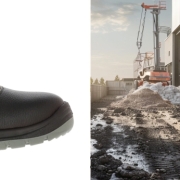The world of workplace safety evolves alongside technological advances, changing materials, and emerging hazards. At the heart of this evolution is the ISO 20345 standard, the global benchmark for safety footwear. The latest revision – ISO 20345:2023 – marks a significant shift from its predecessor, ISO 20345:2011, offering enhanced protection, clarity, and performance criteria. For manufacturers, distributors, safety officers, and wearers alike, understanding these changes is not optional – it’s essential.
Below we explore the importance of ISO 20345:2023, with a specific focus on its impact on steel toe cap safety boots. It also examines the key changes from ISO 20345:2011, why they matter, and how they influence compliance, product design, and workplace safety globally.
1 – The Purpose of ISO 20345 and Why It Matters
1.1 What is ISO 20345?
ISO 20345 is an international standard developed by the International Organization for Standardization (ISO). It defines the minimum requirements for safety footwear used in industrial and commercial environments where foot injuries are a risk.
ISO 20345 ensures that safety footwear is:
- Protective against mechanical impact and compression.
- Resilient to environmental hazards such as heat, cold, fuel, and slipping.
- Standardized across manufacturers and regions globally to ensure consistent quality and performance.
1.2 Why Safety Standards Evolve
Standards evolve to:
- Incorporate new materials and technologies.
- Reflect changes in global workplace practices.
- Respond to newly identified risks (e.g., new industrial environments or tasks).
- Clarify ambiguous language and improve compliance.
The 2023 revision was initiated to address these exact needs and more.
2. The Core of Steel Toe Cap Footwear and Its Role in ISO 20345
2.1 Steel Toe Caps: The Traditional Warrior
Steel toe caps are the oldest and most recognized form of foot protection. Designed to resist 200 joules of impact and 15 kN of compression, they protect the toes from falling objects, heavy loads, and crushing incidents.
Steel remains popular due to:
- Proven durability.
- Consistent manufacturing tolerances.
- High compression and impact resistance.
- Cost-effectiveness at scale.
Despite the rise of composite toe caps (fiberglass, carbon fiber, plastic), steel toe caps continue to be a mainstay in construction, logistics, manufacturing, and heavy-duty applications.
2.2 ISO 20345 and Toe Protection
Both the 2011 and 2023 versions of ISO 20345 categorize toe protection as an SB (Safety Basic) minimum requirement, ensuring:
- Impact resistance up to 200 J.
- Compression resistance up to 15 kN.
However, ISO 20345:2023 further codifies how this protection is tested, recorded, and labelled, making things more transparent and consistent across manufacturers.
3. ISO 20345:2023 – What’s New?
The ISO 20345:2023 revision isn’t just a rewording of the 2011 document. It’s a comprehensive rework, reflecting over a decade of feedback, incidents, and new testing capabilities. Below are the most significant changes and what they mean for steel toe cap footwear.
3.1 Reorganization and Modular Structure
- The standard has been restructured into a modular format.
- It now includes mandatory base requirements and a wide array of optional/additional performance requirements, each represented by specific codes.
- This allows manufacturers to custom-build safety footwear suited to particular environments without ambiguity.
3.2 New Classification Codes
New classification codes such as S6 and S7 have been introduced:
- S6 = All features of S3 + Waterproofing.
- S7 = All features of S5 + Waterproofing and cleated outsole.
These updates make it easier to identify performance levels for waterproof and heavy-duty boots. Steel toe cap boots, previously coded as S3 or S5, now have clearer distinctions when they include waterproof membranes or anti-perforation midsoles.
3.3 Enhanced Slip Resistance Testing
The slip resistance test has changed:
- The old SRC rating (combining the performance of SRA + SRB) has been replaced.
- ISO 20345:2023 removes the SRC label and instead defines two specific test conditions:
- – SR = slip resistance tested on ceramic tiles with glycerol.
- – No code = if footwear does not meet slip resistance or is not tested.
For steel toe cap boots used in construction or oily/greasy environments, this shift makes it easier to trust performance claims—no more confusion about what “SRC” really means.
3.4 Updated Penetration Resistance
- ISO 20345:2023 clarifies the testing of puncture-resistant midsoles.
- Two levels of protection:
- – PL (non-metallic) = flexible textile penetration resistance.
- – PS (steel plate) = traditional steel midsole.
For steel toe cap boots, many still use steel midsoles, and the PS rating now ensures proper labelling and traceability.
3.5 Whole Footwear Testing
Footwear is now evaluated more holistically, not just by individual components. This ensures:
- Steel toe caps perform well inside the boot and not just as a standalone component.
- Fit, flexibility, and durability tests apply to the entire boot, promoting user comfort and extended product life.
3.6 Thermal Risks and Insulation Clarifications
New and refined symbols for thermal risks include:
- HI (Heat Insulation)
- CI (Cold Insulation)
- WG (Waterproof Garment equivalent)
For industries such as mining, smelting, or cold storage – where steel toe boots are commonly used – these ratings allow for better boot selection.
4. Steel Toe Cap Footwear Under ISO 20345:2023
Steel toe cap boots must now meet more comprehensive criteria than in 2011. Let’s explore the specific implications.
4.1 Better Labelling and Certification
Manufacturers must now use clear labels such as:
- SB-PS-SR-HI-CI: A steel toe cap boot with steel puncture resistance, slip resistance, heat and cold insulation.
- Clear icons and modular codes eliminate ambiguous safety claims.
This matters for:
- End users, who can now match boots to exact job hazards.
- Procurement teams, who can vet footwear at a simple glance.
4.2 Stronger Emphasis on Testing
Steel toe boots must demonstrate:
- Repeatability in impact/compression performance, with fewer tolerance variations allowed.
- Endurance against cold and heat transfer through the steel toe—critical in extreme climates.
- Improved flex resistance—steel components must work in tandem with upper and outsole materials.
This results in safer, more reliable boots for daily use in high-risk environments.
4.3 Certification Audits and Manufacturer Accountability
Under ISO 20345:2023:
- Audits require traceability of steel toe materials and suppliers.
- Footwear must withstand life-cycle wear simulation, ensuring long-term performance—not just lab compliance.
Manufacturers now face greater scrutiny, which benefits workers relying on trustworthy gear.
5. ISO 20345:2011 vs ISO 20345:2023 – The Key Differences
| Aspect | ISO 20345:2011 | ISO 20345:2023 |
| Structure | Single integrated standard | Modular, with mandatory + optional requirements |
| Slip Resistance | SRC (SRA + SRB) | SR (new test with ceramic + glycerol); SRC removed |
| Puncture Resistance | P (steel or textile) | Split into PL (textile) and PS (steel) |
| Waterproof Ratings | WR optional, unclear naming | S6 and S7 explicitly define waterproof features |
| Toe Cap Testing | Standalone tests | Toe caps must perform within full footwear |
| Thermal Ratings | Limited | Improved heat, cold, and water insulation rating system |
| Markings/Labelling | Often unclear | Clear modular codes for each performance feature |
| Risk Scenarios | Generalised | Better alignment with specific job site hazards |
6. Implications for Employers and Safety Managers
6.1 Safer Procurement Decisions
The new standard simplifies purchasing:
- Match boots to exact hazards: water, oil, chemicals, heat, etc.
- Avoid over or under specifying safety footwear gear.
- Choose steel toe cap boots with clear PS + SR + CI codes for full protection.
6.2 Improved Compliance and Worker Trust
Workplace audits will be easier:
- Inspectors can confirm boot compliance visually and through documentation.
- Workers gain confidence in their gear, improving morale and safety adherence.
6.3 Long-Term Cost Reduction
Better-labelled, better-built steel toe cap boots:
- Last longer.
- Reduce injury rates and compensation claims.
- Simplify stock management across different teams and sites.
7. Impact on Manufacturers and Retailers
7.1 Design Adjustments
Bootmakers must:
- Retest old products or retire them.
- Re-label and re-document all models.
- Rethink materials, as PS midsole specs demand tighter tolerances.
7.2 Customer Education
Retailers can now explain the new modular codes on all branding, as customers shift from “S3” thinking to “S6-PS-SR-CI-HRO” language. This is a golden opportunity for trusted existing brands to stand out with superior quality and transparency.
8. Consumer Tips: Choosing the Right Steel Toe Cap Boot (Post-2023)
| Your Work Environment | Recommended Codes |
| Construction & Demolition | SB-PS-SR-HRO-WRU |
| Cold Storage / Refrigeration | SB-PS-SR-CI |
| Wet, Slippery Sites | SB-S6-SR |
| Foundry / Heat Work | SB-PS-HRO-HI |
| Logistics / Warehousing | SB-PS-SR |
9. The Future of Safety Footwear and ISO Standards
ISO 20345:2023 sets the groundwork for:
- Smart footwear integration (e.g., sensors, fatigue monitoring).
- Sustainable materials, with testing for biodegradability and recyclability.
- Even greater alignment with regional regulations (like SANS in South Africa. Along with our National Regulators Compulsory Specifications/NRCS requirements).
It raises the bar for what protective footwear can and should be in the modern workplace.
ISO 20345:2023 is more than a revision – it’s a revolution in how we think about foot protection. For steel toe cap safety footwear, it provides:
- Clearer classification.
- Stricter testing.
- Holistic evaluation.
- Better communication with users.
This new standard promotes safety, transparency, and accountability from the boot factory to the jobsite. And while change may require effort—from retesting to retraining—the result is a safer workforce and a clearer global language around protection. In a world where hazards evolve and responsibilities deepen, ISO 20345:2023 ensures steel toe cap boots stay one step ahead.
Please contact any member of the ProFit team should you wish to understand the upcoming changes to the ISO 20345 safety standards. We are already compliant to the new 2023 standards on our Hobo Boot, Hobo Shoe, Parson Boot, Lynx Shoe, Parson S1 Boot and Econo Chelsea Boot ranges. The rest of our safety boot range is currently under certification testing and will be complete before the end of October 2025.



